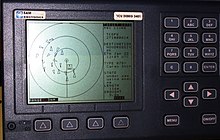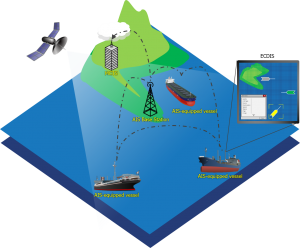
AIS stands for Automatic Identification System. It is a tracking system used in the maritime industry to identify and locate vessels and improve maritime safety. AIS is an automated system that uses VHF radio frequencies to transmit and receive information about a ship’s identity, position, speed, heading, and other relevant information.
The AIS system consists of two parts: the AIS transponder and the AIS receiver. The AIS transponder is installed on the ship and continuously transmits information about the ship’s identity, position, speed, and heading to other vessels and shore stations. The AIS receiver is installed on other ships or shore stations and receives information about other vessels in the vicinity.
AIS is an essential tool for maritime safety as it provides real-time information about the location and movements of other vessels, allowing ships to avoid collisions and navigate safely in congested waters. It is also used by maritime authorities to monitor vessel traffic, enforce maritime regulations, and respond to emergency situations.
Here are some of the key features and benefits of AIS:
- Identification: AIS allows for the identification of vessels, including their name, call sign, and other identifying information. This helps to reduce confusion and improve communication between vessels.
- Location: AIS provides real-time information about the location of vessels, allowing ships to avoid collisions and navigate safely in congested waters.
- Speed and direction: AIS provides information about the speed and direction of vessels, allowing ships to anticipate their movements and take appropriate action to avoid collisions.
- Integration: AIS can be integrated with other navigation systems such as radar and Electronic Chart Display and Information System (ECDIS), providing a more comprehensive view of the ship’s surroundings.
- Safety: AIS enhances maritime safety by providing real-time information about the location and movements of other vessels, allowing ships to avoid collisions and navigate safely in congested waters.
- Regulation: AIS is used by maritime authorities to monitor vessel traffic and enforce maritime regulations, ensuring that ships comply with safety and environmental standards.
AIS is an essential tool for safe and efficient navigation in the maritime industry. It provides real-time information about the location and movements of vessels, allowing ships to avoid collisions and navigate safely in congested waters. It is also used by maritime authorities to monitor vessel traffic and enforce maritime regulations.
Automatic Identification System (AIS) Is Mandatory Under SOLAS Convention
Automatic Identification System (AIS) is mandatory for most commercial ships under the regulations of the International Maritime Organization (IMO). The IMO requires AIS to be installed on all vessels over 300 gross tonnage and all passenger ships, regardless of size. The requirement is part of the International Convention for the Safety of Life at Sea (SOLAS), which sets out minimum safety standards for ships. The purpose of the mandatory AIS requirement is to enhance safety and security in the maritime industry by providing real-time information about the location and movements of vessels. AIS allows ships to avoid collisions and navigate safely in congested waters by providing information about the identity, position, speed, and heading of other vessels in the vicinity. The system is also used by maritime authorities to monitor vessel traffic, enforce maritime regulations, and respond to emergency situations.
Under SOLAS regulations, AIS must be installed, maintained, and operated in accordance with international standards. The system must be continuously operational while the ship is at sea, and the information transmitted must be accurate and up-to-date. Ships that are not in compliance with the AIS regulations may be subject to penalties, including detention or refusal of entry into ports. In addition to the mandatory AIS requirement for most commercial ships, the IMO has also established guidelines for the use of AIS in various maritime applications, such as search and rescue operations and pollution prevention. These guidelines provide additional recommendations for the use of AIS to enhance safety and efficiency in the maritime industry.
Understanding the Function and Importance of the Automatic Identification System (AIS)
The Automatic Identification System (AIS) is a tracking system used in the maritime industry to identify and locate vessels and improve maritime safety. AIS is an automated system that uses VHF radio frequencies to transmit and receive information about a ship’s identity, position, speed, heading, and other relevant information.

Here’s how AIS works and functions on ships:
- AIS transponder: An AIS transponder is installed on the ship, which continuously transmits information about the ship’s identity, position, speed, and heading to other vessels and shore stations. The AIS transponder uses VHF radio frequencies to transmit the information.
- AIS receiver: An AIS receiver is installed on other ships or shore stations, which receives information about other vessels in the vicinity. The AIS receiver also uses VHF radio frequencies to receive the information transmitted by the AIS transponder.
- VHF frequencies: AIS uses two VHF frequencies, AIS1 (161.975 MHz) and AIS2 (162.025 MHz), to transmit and receive information. These frequencies are separate from the channels used for voice communication and are reserved exclusively for AIS.
- Data transmission: The AIS transponder continuously transmits data about the ship’s identity, position, speed, heading, and other relevant information in a specific format. This data is received by the AIS receiver on other ships or shore stations, which can display the information on a screen.
- AIS data exchange: When two ships with AIS are in range of each other, their AIS transponders exchange data automatically. This allows each ship to display the other ship’s position and other relevant information on its AIS display.
- Integration: AIS can be integrated with other navigation systems such as radar and Electronic Chart Display and Information System (ECDIS), providing a more comprehensive view of the ship’s surroundings.
Overall, AIS is an essential tool for safe and efficient navigation in the maritime industry. It provides real-time information about the location and movements of vessels, allowing ships to avoid collisions and navigate safely in congested waters. It is also used by maritime authorities to monitor vessel traffic and enforce maritime regulations.
The Potential Safety and Security Risks of Using AIS in the Maritime Industry
While the Automatic Identification System (AIS) is a critical tool for enhancing safety and security in the maritime industry, it is not without safety and security risks. Here are some of the potential safety and security risks associated with using AIS on board ships:
- Over-reliance: One of the main safety risks associated with AIS is over-reliance on the system. The navigator may become too dependent on the system and not pay enough attention to other navigational aids, such as radar or visual observations.
- Incorrect data: AIS relies on accurate data entry to provide reliable information. However, incorrect data entry or errors in the electronic charts can lead to incorrect information being displayed on the screen, potentially leading to a navigational error.
- Cybersecurity: AIS systems are connected to the ship’s network, which can make them vulnerable to cyber attacks. A hacker could potentially gain access to the system and manipulate the information displayed on the screen, leading to a navigational error or other safety risks.
- Privacy: AIS broadcasts information about the ship’s identity, position, speed, and heading to other vessels and shore stations, which can compromise the ship’s privacy and security. The information transmitted can be used by pirates or other malicious actors to track the ship’s movements and plan attacks.
- Interference: AIS relies on VHF radio frequencies to transmit and receive information, which can be subject to interference from other radio signals. This can lead to a loss of critical information and potentially result in a navigational error.
To mitigate these safety and security risks, it is essential to provide proper training to the crew on the use of AIS and to ensure that they understand its limitations and potential risks. Regular testing and maintenance of the system are also necessary to ensure that it is functioning correctly and providing accurate information. Backup navigation systems, such as radar and Electronic Chart Display and Information System (ECDIS), should also be available in case of AIS system failure. Finally, cybersecurity measures should be implemented to protect the AIS system from potential cyber attacks, and privacy concerns should be addressed by limiting the information transmitted by AIS to only what is necessary for safety and security purposes.
Prepared by the MaritimEducation team.

